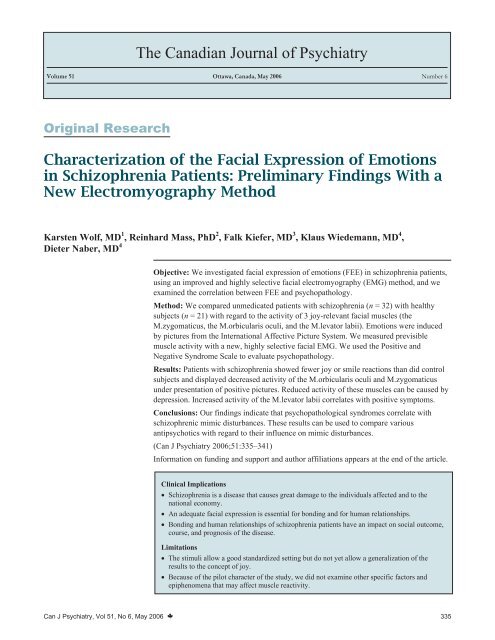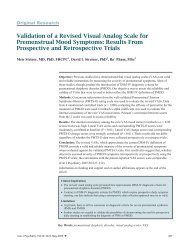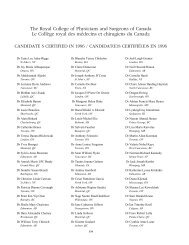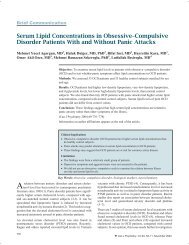The Canadian Journal of Psychiatry - Canadian Psychiatric ...
The Canadian Journal of Psychiatry - Canadian Psychiatric ...
The Canadian Journal of Psychiatry - Canadian Psychiatric ...
You also want an ePaper? Increase the reach of your titles
YUMPU automatically turns print PDFs into web optimized ePapers that Google loves.
<strong>The</strong> <strong>Canadian</strong> <strong>Journal</strong> <strong>of</strong> <strong>Psychiatry</strong><br />
Volume 51 Ottawa, Canada, May 2006 Number 6<br />
Original Research<br />
Characterization <strong>of</strong> the Facial Expression <strong>of</strong> Emotions<br />
in Schizophrenia Patients: Preliminary Findings With a<br />
New Electromyography Method<br />
Karsten Wolf, MD 1 , Reinhard Mass, PhD 2 , Falk Kiefer, MD 3 , Klaus Wiedemann, MD 4 ,<br />
Dieter Naber, MD 4<br />
Objective: We investigated facial expression <strong>of</strong> emotions (FEE) in schizophrenia patients,<br />
using an improved and highly selective facial electromyography (EMG) method, and we<br />
examined the correlation between FEE and psychopathology.<br />
Method: We compared unmedicated patients with schizophrenia (n = 32) with healthy<br />
subjects (n = 21) with regard to the activity <strong>of</strong> 3 joy-relevant facial muscles (the<br />
M.zygomaticus, the M.orbicularis oculi, and the M.levator labii). Emotions were induced<br />
by pictures from the International Affective Picture System. We measured previsible<br />
muscle activity with a new, highly selective facial EMG. We used the Positive and<br />
Negative Syndrome Scale to evaluate psychopathology.<br />
Results: Patients with schizophrenia showed fewer joy or smile reactions than did control<br />
subjects and displayed decreased activity <strong>of</strong> the M.orbicularis oculi and M.zygomaticus<br />
under presentation <strong>of</strong> positive pictures. Reduced activity <strong>of</strong> these muscles can be caused by<br />
depression. Increased activity <strong>of</strong> the M.levator labii correlates with positive symptoms.<br />
Conclusions: Our findings indicate that psychopathological syndromes correlate with<br />
schizophrenic mimic disturbances. <strong>The</strong>se results can be used to compare various<br />
antipsychotics with regard to their influence on mimic disturbances.<br />
(Can J <strong>Psychiatry</strong> 2006;51:335–341)<br />
Information on funding and support and author affiliations appears at the end <strong>of</strong> the article.<br />
Clinical Implications<br />
Schizophrenia is a disease that causes great damage to the individuals affected and to the<br />
national economy.<br />
An adequate facial expression is essential for bonding and for human relationships.<br />
Bonding and human relationships <strong>of</strong> schizophrenia patients have an impact on social outcome,<br />
course, and prognosis <strong>of</strong> the disease.<br />
Limitations<br />
<strong>The</strong> stimuli allow a good standardized setting but do not yet allow a generalization <strong>of</strong> the<br />
results to the concept <strong>of</strong> joy.<br />
Because <strong>of</strong> the pilot character <strong>of</strong> the study, we did not examine other specific factors and<br />
epiphenomena that may affect muscle reactivity.<br />
Can J <strong>Psychiatry</strong>, Vol 51, No 6, May 2006 335
<strong>The</strong> <strong>Canadian</strong> <strong>Journal</strong> <strong>of</strong> <strong>Psychiatry</strong>—Original Research<br />
Key Words: facial expression <strong>of</strong> emotions, mimic<br />
disturbance, psychopathology<br />
For a long time, clinical observations suggested a lack <strong>of</strong><br />
facial expressiveness in patients with schizophrenia. Further,<br />
occasional bizarre facial movements were already<br />
described by Kraepelin (1) and later defined as “mimic disintegration”<br />
by Heimann (2) and Spoerri (3) on the basis <strong>of</strong> systematic<br />
observation. Heimann and Spoerri describe the term<br />
“mimic desintegration”(in German, Mimische<br />
Desintegration) as mimic patterns that cannot obviously be<br />
assigned to any known productive expression, and an<br />
“impression <strong>of</strong> not belonging together and <strong>of</strong> alterations” (2,<br />
p 1128) is conveyed to the observer.<br />
Since Ekmans work, these mimic disturbances can be investigated<br />
empirically. Ekman postulates 6 basic emotions<br />
expressed through specific facial movements. <strong>The</strong>y can be<br />
identified with a video-based analyzing system called the<br />
FACS (4). <strong>The</strong>se 6 emotions are joy, disgust and contempt,<br />
aggression, sorrow, surprise, and anxiety. Each emotion is<br />
characterized by a specific pattern <strong>of</strong> “action units,” which are<br />
based on specific patterns <strong>of</strong> facial muscle activity. Integrated<br />
and organized mimic reactions in general are <strong>of</strong> great importance<br />
for social relations, with smiling being a key player in<br />
the expression <strong>of</strong> joy. <strong>The</strong>re are at least 3 types <strong>of</strong> smiles (5–<br />
7): the “felt smile” (caused by activation <strong>of</strong> M.zygomaticus<br />
plus M.orbicularis oculi), the social smile (activation <strong>of</strong><br />
M.zygomaticus alone), and the masking smile <strong>of</strong> the disgust<br />
or contempt type (caused by activation <strong>of</strong> M.zygomaticus plus<br />
M.levator labii). However, Ekman’s method <strong>of</strong> measuring<br />
Abbreviations used in this article<br />
CMRR<br />
COG<br />
CON<br />
DEP<br />
EMG<br />
EPS<br />
EXC<br />
FACS<br />
FEE<br />
IAPS<br />
NEG<br />
NS<br />
PANSS<br />
POS<br />
SCH<br />
SD<br />
common mode rejection ratio<br />
cognitive syndrome<br />
control<br />
depression<br />
electromyography<br />
Extrapyramidal Side Effects Scale<br />
hostile excitement<br />
Facial Action Coding System<br />
facial expression <strong>of</strong> emotions<br />
International Affective Pictures Scale<br />
negative syndrome<br />
not significant<br />
Positive and Negative Syndrome Scale<br />
positive syndrome<br />
schizophrenia<br />
standard deviation<br />
visible movements is limiting, and even microcomputerbased<br />
methods (8–10) do not solve these limitations.<br />
Modern EMG techniques provide a more precise measurement<br />
<strong>of</strong> the entire muscle activity, including the important<br />
previsible facial muscle actvity. Dimberg (11–14) was the<br />
first to prove the validity <strong>of</strong> the EMG method by matching<br />
EMG data to certain kinds and intensities <strong>of</strong> emotions. In<br />
addition, he was able to show the existence <strong>of</strong> “rapid facial<br />
reactions” (14).<br />
However, all EMG methods applied thus far fail to reach sufficient<br />
levels <strong>of</strong> both sensitivity and selectivity. In this context,<br />
selectivity means the ability <strong>of</strong> an EMG method to isolate<br />
the facial muscle targeted for measurement. Altogether, the<br />
more sensitive an EMG, the less selective it tends to be. For<br />
this reason, all previous EMG studies were unable to measure<br />
more than 2 to 3 facial muscles simultaneously.<br />
A new EMG method has become available, <strong>of</strong>fering sensitivity<br />
and selectivity at the same time. <strong>The</strong> new method facilitates<br />
the simultaneous measurement <strong>of</strong> 9 facial muscles. <strong>The</strong> validity<br />
<strong>of</strong> this method was recently established in 2 studies <strong>of</strong><br />
healthy subjects (15,16).<br />
This study aimed to use this improved EMG method to identify<br />
the well-known and indisputable mimic disturbances <strong>of</strong><br />
unmedicated schizophrenia patients.<br />
Unmedicated schizophrenia patients show a reduced<br />
frequency <strong>of</strong> joy (7,17), a preponderance <strong>of</strong> negative emotions<br />
(18), and a reduced mimic activity, especially <strong>of</strong> the<br />
upper face (19). In contrast, schizophrenia patients in remission<br />
show a reduced mimic activity, especially <strong>of</strong> the lower<br />
face (20). One study investigated an increased activity <strong>of</strong> the<br />
area around the nose, caused by the M.levator labii (21). A<br />
recent study investigated a reduced facial activity, especially<br />
in the upper face in acute schizophrenia patients and a stability<br />
<strong>of</strong> this pattern in the acute illness course and in remitted<br />
schizophrenia patients (22). EMG studies measuring the<br />
activity <strong>of</strong> M. zygomaticus and M. corrugator found a reduced<br />
activity <strong>of</strong> the smile muscle, M. zygomaticus, in unmedicated<br />
schizophrenia patients (19,23,24)<br />
Methods<br />
Subjects<br />
<strong>The</strong> sample group comprised 32 inpatients with schizophrenia<br />
(DSM-IV 295, SCH) and 21 healthy control subjects (CON).<br />
Of the SCH group, 28 were first-episode patients, 3 were<br />
second-episode patients, and 1 was a fourth-episode patient.<br />
<strong>The</strong> current evaluation is part <strong>of</strong> an ongoing extensive project<br />
about the longitudinal course <strong>of</strong> FEE in schizophrenia<br />
patients. Patients met DSM-IV criteria for schizophrenia (25)<br />
and had no other current diagnosis. All were inpatients, tested<br />
on the first day after admission. None <strong>of</strong> the patients had<br />
336<br />
Can J <strong>Psychiatry</strong>, Vol 51, No 6, May 2006
Characterization <strong>of</strong> the Facial Expression <strong>of</strong> Emotions in Schizophrenia Patients: Preliminary Findings With a New Electromyography Method<br />
received any antipsychotic medication for at least 1 month and<br />
(or) benzodiazepines for at least 3 half-life periods <strong>of</strong> the<br />
respective compound. Patients had to be without any other<br />
psychotropic medication or substances for at least 3 months.<br />
<strong>The</strong> healthy control subjects had never suffered from any psychiatric<br />
illness, had no family history <strong>of</strong> psychiatric disturbances,<br />
and had not received any psychotropic substances for<br />
at least 3 months (see Table 1 for sample characteristics). <strong>The</strong><br />
study was approved by the local ethics committee <strong>of</strong> the University<br />
<strong>of</strong> Hamburg, and written informed consent was<br />
obtained from all participants prior to the study.<br />
Induction <strong>of</strong> Emotions<br />
All subjects were tested under video observation in an electrically<br />
shielded, soundpro<strong>of</strong> chamber with reduced light, sitting<br />
in a comfortable chair. All tests were scheduled between 1 PM<br />
and 3 PM. Subjects were allowed to adapt to the surroundings<br />
in the room for 30 minutes prior to testing, while being asked<br />
about their present psychosocial situation. Afterwards, subjects<br />
were asked to relax, look at the presented pictures, and<br />
refrain from voluntary movement <strong>of</strong> the body, head, or face.<br />
<strong>The</strong>n, the patients and the healthy subjects were exposed to<br />
slides with neutral, joyful, and sad stimuli. <strong>The</strong> exposure time<br />
(10 seconds per picture) was controlled electronically. <strong>The</strong><br />
first picture, before the stimulus slides were shown, was a grey<br />
baseline picture presented for 2 minutes, which induced a<br />
relaxed psychophysiological state.<br />
For testing, we chose 11 pictures from the IAPS, with different<br />
series for women and men to acknowledge sexual preferences.<br />
Each picture was preceded by a grey baseline picture<br />
(presentation time 15 seconds). Two neutral pictures were followed<br />
by a picture <strong>of</strong> flowers and a picture <strong>of</strong> a landscape,<br />
from which we expected the emotion <strong>of</strong> relaxed joy. <strong>The</strong>n, we<br />
presented an erotic picture <strong>of</strong> a single person, followed by an<br />
erotic picture <strong>of</strong> a couple, presuming the emotion <strong>of</strong> joy plus<br />
arousal for both pictures, on the basis <strong>of</strong> the results <strong>of</strong> IAPS<br />
research by Lang (26). After showing 2 pictures, one with a<br />
family and the second with a child, we presented one picture<br />
with sad content as a control picture. Finally, the landscape<br />
picture and the erotic picture <strong>of</strong> a single person were presented<br />
again. <strong>The</strong> results are based on the analysis <strong>of</strong> the following<br />
pictures: for women, IAPS number 8041(T0), number 4510<br />
(T1), and number 4533 (T2); and for men, IAPS number 4180<br />
(T0), 4210 (T1), and 4220 (T2). We chose these pictures<br />
because <strong>of</strong> their proven effect to induce joy (26).<br />
EMG Measures<br />
We used a modified EMG device (that is, the Advanced Emotion<br />
Finder, Hamburg/Karlsruhe, 2000), based on the<br />
Varioport system (Becker MEDITEC, Karlsruhe, Germany,<br />
2000), without relevant interference among muscles, that<br />
allows a high selectivity and therefore a sufficient<br />
discrimination among muscles close to one another. Bipolar<br />
EMG recordings were taken from the left M. frontalis<br />
medialis, M. corrugator supercilii, M. orbicularis oculi, M.<br />
levator labii, and M. zygomaticus region on the face, with<br />
Hellige miniature surface Ag/AgCl electrodes (inside diameter<br />
0.6 cm) filled with Med-Tek/Synapse conductive electrode<br />
cream. <strong>The</strong> electrodes were placed according to the recommendations<br />
<strong>of</strong> Fridlund and Cacioppo (27). <strong>The</strong><br />
interelectrode distances were 12 mm. Skin was prepared by<br />
abrasion with 70% clinical alcohol first and then Hellige<br />
Epicont abrasive skin preparation cream. <strong>The</strong> electrodes were<br />
connected to Advanced Emotion Finder Amplifiers, and the<br />
raw EMG signal was analyzed automatically by a 2-channel<br />
contour-following integrator (Advanced Emotion Finder,<br />
Hamburg, Germany, 2000) as follows: frequency range<br />
(3 dB) <strong>of</strong> 90 to 500 Hz with a time constant <strong>of</strong> 0.0018 s, amplification<br />
factor 5000 ( 2%), common mode rejection ratio<br />
(77 dB at 50 Hz, time constant <strong>of</strong> integrator 0.1 s, range<br />
± 250 V, resolution <strong>of</strong> AD-Converter 12 Bit (= 4096 steps),<br />
resolution <strong>of</strong> signal 0.122 V per step. <strong>The</strong> input impedance is<br />
theoretically 1Gohm; owing to our cable capacities, it is about<br />
500 Mohm at 50 Hz. <strong>The</strong> sampling rate was 32 Hz. <strong>The</strong> output<br />
signals were recorded and stored in computer files<br />
(Variograph s<strong>of</strong>tware on a Macintosh Power book, Becker<br />
MEDITEC, Karlsruhe, Germany, 2000) for <strong>of</strong>f-line analysis.<br />
With the help <strong>of</strong> video recordings, the complete EMG data<br />
were screened for artifacts like eye blinking. Artifacts were<br />
interpolated with the Variograph s<strong>of</strong>tware (Becker<br />
MEDITEC, Karlsruhe, Germany, 2000).<br />
Psychopathological Symptoms<br />
<strong>The</strong> patient’s psychopathological status was determined with<br />
the PANSS (28). Extrapyramidal symptoms were evaluated<br />
with the EPS (29). For the present analyses, we considered<br />
5 syndromes yielded by factor analysis underlying the 30<br />
PANSS items (30): POS, items P1, P3, G9; NEG, items N4,<br />
N2, N1, N3, G16, N6; COG, Items N5, G11, P2; DEP, items<br />
G6, G2, G3; and EXC, items P7, P4, G14, G4, G8, P5, G5.<br />
Statistical Analyses<br />
<strong>The</strong> statistical analysis is based on the activities <strong>of</strong> the 3<br />
joy-relevant muscles (that is, the M.zygomaticus, the<br />
M.orbicularis oculi, and the M.levator labii) and on the presentation<br />
<strong>of</strong> the positive picture.<br />
As our EMG baseline value, we established the average <strong>of</strong> the<br />
measures obtained during the last 3 seconds <strong>of</strong> the 15-second<br />
presentation <strong>of</strong> the grey picture shown before each IAPS stimulus.<br />
As the trial phase, we used the 10-second presentation <strong>of</strong><br />
the IAPS stimulus.<br />
We defined “facial muscle reaction” as an increase in mean<br />
muscular voltage during the trial (that is, during the picture<br />
Can J <strong>Psychiatry</strong>, Vol 51, No 6, May 2006 337
<strong>The</strong> <strong>Canadian</strong> <strong>Journal</strong> <strong>of</strong> <strong>Psychiatry</strong>—Original Research<br />
Table 1 Sample characteristics, PANSS syndrome ratings<br />
Schizophrenia group<br />
(n = 32)<br />
Control group<br />
(n = 21)<br />
Age a , mean (SD) 31.8 (9.0) 25.2 (3.2)<br />
Duration <strong>of</strong> illness, a,c mean (SD) 3.3 (5.1) —<br />
ICD-10 diagnosis F20.0 —<br />
n (%)<br />
Sex: male 16 (50.0) 7 (33.3)<br />
Educational level<br />
No degree<br />
1 (3.1)<br />
Elementary school<br />
6 (18.8)<br />
Middle school<br />
9 (28.1)<br />
High school b 16 (50.0)<br />
First-episode patients<br />
Second-episode patients<br />
3 episodes patients<br />
28 (87.5)<br />
3 (9.4)<br />
1 (3.1)<br />
Mean (SD), range<br />
0 (0)<br />
0 (0)<br />
0 (0)<br />
21 (100)<br />
(12 students, 9 clinic staff)<br />
PANSS positive syndrome 2.42 (1.23), 1.00–4.67 —<br />
PANSS negative syndrome 1.87 (0.75), 1.00–3.67 —<br />
PANSS cognitive syndrome 2.18 (0.88), 1.00–4.00 —<br />
PANSS depressive syndrome 2.37 (1.05), 1.00–5.33 —<br />
PANSS excitement syndrome 1.58 (0.45), 1.00–3.00 —<br />
a In years<br />
b Qualifying for entrance to university<br />
c Age at time <strong>of</strong> age at investigation minus age at first prodromal sign<br />
— = no data<br />
—<br />
—<br />
—<br />
exposition). <strong>The</strong> increase had to be greater than the mean<br />
value <strong>of</strong> the preceding baseline plus 2 baseline SDs. A “smile<br />
response” was defined as a reaction <strong>of</strong> the M. zygomaticus<br />
major alone or in combination with a reaction <strong>of</strong> the M. levator<br />
labii and (or) the M. orbicularis oculi.<br />
To calculate changes <strong>of</strong> facial muscle activity, we determined<br />
the difference between mean voltage observed during the trial<br />
and mean voltage observed during baseline.<br />
All statistical analyses were conducted with the Statistical<br />
Package for the Social Sciences (Version 6.1.1, for Macintosh<br />
1999). We tested baseline-to-trial changes <strong>of</strong> muscular activity<br />
(the averaged mean) with paired t tests for both groups and<br />
within the groups for each muscle, separately. We tested<br />
group differences <strong>of</strong> smile response frequencies with<br />
chi-square tests. To examine the relation between facial muscular<br />
reactions and psychopathologic symptoms, we<br />
calculated parametric correlation coefficients (r yx ) for the<br />
patients with schizophrenia.<br />
To test the hypotheses, we accepted P values <strong>of</strong> 0.05, 0.01,<br />
and 0.001 as nominal levels <strong>of</strong> significance, high significance<br />
and very high significance, respectively. Hypothesis testing<br />
was 2-tailed.<br />
Because we wanted to use the original scales <strong>of</strong> the single<br />
PANSS items (rated from 1 = nonexistent to 7 = extreme) for<br />
an interpretation <strong>of</strong> the PANSS syndromes, we calculated the<br />
arithmetic medium instead <strong>of</strong> the sum score when describing<br />
the syndromes. <strong>The</strong> highest means were observed for the POS<br />
and DEP syndromes, respectively; the lowest mean was<br />
observed for the EXC syndrome (Table 1).<br />
Results<br />
Table 2 shows the EMG measurement results from both test<br />
groups. We included 3 facial muscles in this study.<br />
338<br />
Can J <strong>Psychiatry</strong>, Vol 51, No 6, May 2006
Characterization <strong>of</strong> the Facial Expression <strong>of</strong> Emotions in Schizophrenia Patients: Preliminary Findings With a New Electromyography Method<br />
Table 2 Comparisons (paired t tests) <strong>of</strong> averaged mean and maximum EMG measures obtained<br />
during baseline and trial conditions, respectively<br />
Group Baseline average (mV) Trial average (mV) Significance<br />
(2-tailed)<br />
Schizophrenia<br />
M.orbicularis (mean) 1.37 2.74 P < 0.05<br />
M. orbicularis (maximum) 3.56 10.00 P < 0.05<br />
M. levator (mean) 2.90 5.10 ns<br />
M. levator (maximum) 5.48 11.97 P < 0.1<br />
M. zygomaticus (mean) 7.26 8.49 ns<br />
M. zygomaticus (maximum) 11.26 17.40 ns<br />
M.orbicularis (mean) 0.27 2.08 P
<strong>The</strong> <strong>Canadian</strong> <strong>Journal</strong> <strong>of</strong> <strong>Psychiatry</strong>—Original Research<br />
Table 3 Pearson correlations (significance) between facial muscle tension changes and PANSS<br />
syndromes, schizophrenia sample (n = 32); 2-tailed<br />
M. orbicularis oculi M. levator labii M. zygomaticus major<br />
PANSS positive syndrome 0.39* 0.30** 0.42*<br />
PANSS negative syndrome –0.36* –0.24 –0.26<br />
PANSS cognitive syndrome –0.00 0.06 0.06<br />
PANSS depressive syndrome –0.36* –0.34** –0.33**<br />
PANSS excitement syndrome 0.00 0.09 0.05<br />
*P < 0.05; **P < 0.1<br />
in smile reactions. <strong>The</strong>se results were independent from the<br />
etiology, and therefore similar in depression and schizophrenia<br />
patients.<br />
Another important finding <strong>of</strong> our study is the correlation<br />
between the POS syndrome and the increase in M. levator<br />
labii activity. With the use <strong>of</strong> the FACS, Steimer-Krause measured<br />
an increased activity <strong>of</strong> Action Unit 9 in patients with<br />
schizophrenia (21). Action Unit 9 activity is caused by the<br />
activity <strong>of</strong> M. levator labii and—according to Ekman and<br />
Friesen (4–6)–is an expression <strong>of</strong> disgust or contempt.<br />
Steimer–Krause believes this finding to be specific for schizophrenia<br />
patients and discusses it as a protection against closeness.<br />
We disagree, since the previsible activity <strong>of</strong> the M.<br />
levator labii, when measured with a facial EMG method such<br />
as ours, is not a specific expression <strong>of</strong> disgust, as proven in a<br />
recent study (15).<br />
One possible explanation for the correlation <strong>of</strong> the positive<br />
syndrome and the increased activity <strong>of</strong> the M. levator labii<br />
superioris might be the mimic disintegration, as proposed by<br />
Heimann and Spoerri (2,3). <strong>The</strong>y investigated whether it is<br />
possible to identify mimic disintegration in unmedicated<br />
schizophrenia patients. Mimic disintegration is defined as the<br />
inability to organize the singular facial muscle movements in<br />
such a way that they present an integrated whole. Mimic disintegration<br />
makes it difficult for observers to decode the emotional<br />
state, since these facial actions seem indecipherable and<br />
bizarre. Without a sufficient decoding <strong>of</strong> the emotional state<br />
<strong>of</strong> the person in front <strong>of</strong> you, it is difficult to establish contact<br />
or to develop a deeper relationship with him or her. <strong>The</strong> link<br />
between mimic disintegration and M.levator labii activity was<br />
further supported by another recent study (32).<br />
To understand these results in depth, it is necessary to collect<br />
larger samples, to distinguish between the different types <strong>of</strong><br />
smiles, and to further investigate the correlation between<br />
mimic disintegration and psychopathology. To understand<br />
the etiology <strong>of</strong> the reduced FEE, it would also be necessary to<br />
include eye tracking. Our present results recommend further<br />
studies <strong>of</strong> schizophrenia patients, especially in regard to the<br />
positive and negative syndromes, using an EMG method that<br />
allows the simultaneous measurement <strong>of</strong> up to 10 facial muscles.<br />
Such a broad measurement would allow the analysis <strong>of</strong><br />
other emotions like appetence, disgust, pain, or fear—<br />
emotions that might be affected in schizophrenia patients as<br />
well. In this context, studies comparing the effect <strong>of</strong><br />
antipsychotics are <strong>of</strong> great importance, since the effects <strong>of</strong><br />
antipsychotics on FEE are largely unknown.<br />
Funding and Support<br />
This study received no funding or support.<br />
References<br />
1. Kraepelin E. Psychiatrie: ein lehrbuch für studierende und ärzte. Leipzig: Barth;<br />
1883.<br />
2. Heimann H, Spoerri T. Das ausdruckssyndrom der mimischen desintegrierung<br />
bei chronischen schizophrenen. Schweiz Med Wochenschr 1957;Suppl:1126 –32.<br />
3. Heimann H. Die quantitative analyse mimischer bewegungen und ihre<br />
anwendung in der pharmako-psychiatrie. Arzneimittelforschung 1966;16:294 –7.<br />
4. Ekman P, Friesen WV. <strong>The</strong> Facial Acting Coding System: a technique for the<br />
measurement <strong>of</strong> facial movement. Palo Alto (CA): Consulting Psychologists<br />
Press; 1978.<br />
5. Ekman P. Darwin and facial expression. New York: Academic Press; 1973.<br />
6. Ekman P. Emotion in the human face. 2nd ed. Cambridge: University Press;<br />
1982.<br />
7. Baenninger-Huber E. Mimik – übertragung – interaktion: die untersuchung<br />
affektiver prozesse in der psychotherapie. Bern: Huber; 1996.<br />
8. Katsikitis M. <strong>The</strong> quantification <strong>of</strong> smiling using a microcomputer-based<br />
approach. <strong>Journal</strong> Of Nonverbal Behaviour 1990;14:3–17.<br />
9. Pilowsky I, Katsikitis M. <strong>The</strong> classification <strong>of</strong> facial emotions: acomputer-based<br />
taxonomic approach. J Affect Disord 1994; 30:61–71.<br />
10. Thornton M, Pilowsky I. Facial expressions can be modelled mathematically.<br />
Br J <strong>Psychiatry</strong> <strong>Psychiatry</strong> 1982;140:61–3.<br />
11. Dimberg U. Facial reactions to facial expressions. Psychophysiology<br />
1982;19:643–7.<br />
12. Dimberg U. Facial electromyography and the experience <strong>of</strong> emotion.<br />
Psychophysiology 1988;3:277–82.<br />
13. Dimberg U. Facial electromyography and emotional reactions.<br />
Psychophysiology 1990;27:481–94.<br />
14. Dimberg U. Rapid facial reactions to emotional facial expressions. Scand J<br />
Psychol 1998;39:39–45.<br />
15. Wolf K, Mass R, Kiefer F, Naber D, Wiedemann K. <strong>The</strong> facial pattern <strong>of</strong> disgust,<br />
appetence, excited joy and relaxed joy – an improved facial EMG study. Scand J<br />
Psychol 2005; 46:403–9.<br />
16. Wolf K, Mass R, Kiefer F, Naber D, Wiedemann K. <strong>The</strong> face <strong>of</strong> pain – a pilot<br />
study to validate the measurement <strong>of</strong> facial pain expression with an improved<br />
electromyogram method. Pain Res Manag 2005;10:15–9.<br />
340<br />
Can J <strong>Psychiatry</strong>, Vol 51, No 6, May 2006
Characterization <strong>of</strong> the Facial Expression <strong>of</strong> Emotions in Schizophrenia Patients: Preliminary Findings With a New Electromyography Method<br />
17. Colby CZ, Lanzetta JT, Kleck RE. Effects <strong>of</strong> the expression <strong>of</strong> pain on<br />
autonomic and pain tolerance responses to subject-controlled pain.<br />
Psychophysiology 1996;14:537–40.<br />
18. Scherer KR. On the nature and function <strong>of</strong> emotion: acomponent process<br />
approach. In: Scherer KR, Ekman P, editors. Approaches to emotion. Hillsdale<br />
(NY) : Lawrence Erlbaum; 1984.<br />
19. Scherer K. <strong>The</strong>orien und aktuelle probleme der emotionspsychologie. In: Scherer<br />
KR, editor. Psychologie der emotionen. Göttingen: Hogrefe; 1990.<br />
20. Mattes RM, Schneider F, Heimann H, Birbaumer N. Reduced emotional<br />
response <strong>of</strong> schizophrenic patients in remission during social interaction.<br />
Schizophr Res 1995;17:249–55.<br />
21. Steimer-Krause E. Interaction regulations used by schizophrenic and<br />
psychosomatic patients: studies on facial behaviour in dyadic interactions.<br />
<strong>Psychiatry</strong> 1990;53:209–28.<br />
22. Gaebel W. Facial expressivity in the course <strong>of</strong> schizophrenia and depression.<br />
Eur Arch <strong>Psychiatry</strong> Clin Neurosci 2004;254:335–42.<br />
23. Kring AM, Neale JM. Do patients with schizophrenia show a disjunctive<br />
relationship among expressive, experimental and psychophysiological<br />
components <strong>of</strong> emotion? J Abnorm Psychol 1996;105:249–57.<br />
24. Schneider F, Ellgring H, Friedrich J, Fus I, Beyer T, Heimann H. <strong>The</strong> effects <strong>of</strong><br />
neuroleptics on facial action in patients with schizophrenia. Pharmacopsychiatry<br />
1992;25:233–9.<br />
25. American <strong>Psychiatric</strong> Association. Diagnostic and statistical manual <strong>of</strong> mental<br />
disorders. 4th ed. Washington (DC): APA; 1994.<br />
26. Lang P. Looking at pictures: affective, facial, visceral, and behavioral reactions.<br />
Psychophysiology 1993;30:261–73.<br />
27. Fridlund AJ, Cacioppo JT. Guidelines for human electromyographic research.<br />
Psychophysiology 1986;23:567–89.<br />
28. Kay SR, Fiszbein A, Opler LA. <strong>The</strong> Positive and Negative Syndrome Scale<br />
(PANSS) for schizophrenia. Schizophr Bull 1987;13:261–7.<br />
29. Simpson GM, Angus JWS. A rating scale for extrapyramidal side effects. Acta<br />
<strong>Psychiatric</strong>a Scand 1970;Suppl(212):11–9.<br />
30. Mass R, Schömig T, Hitschfeld K, Wall E, Haasen C. Psychopathological<br />
syndromes <strong>of</strong> schizophrenia. Evaluation <strong>of</strong> the dimensional structure <strong>of</strong> the<br />
Positive and Negative Syndrome Scale (PANSS). Schizophr Bull<br />
2000;26:167–77.<br />
31. Ellgring D. Nonverbal communication in depression. Cambridge: Cambridge<br />
University Press; 1989.<br />
32. Wolf K, Köppel S, Maß R, Naber D. Bestätigung des Heimann’schen konzeptes<br />
zur mimischen desintegration schizophrener patienten mittels einer neuen<br />
Gesichts-EMG Methode. Nervenarzt 2005;76:1103–8.<br />
Manuscript received February 2005, revised, and accepted February 2006.<br />
1 Psychiatrist and Psychotherapist, Department <strong>of</strong> <strong>Psychiatry</strong> and<br />
Psychotherapy, University Hospital <strong>of</strong> Hamburg, Hamburg, Germany;<br />
Center <strong>of</strong> Mental Health Marienheide, Marienheide, Germany.<br />
2 Pr<strong>of</strong>essor and Clinical Psychologist, Department <strong>of</strong> <strong>Psychiatry</strong> and<br />
Psychotherapy, University Hospital <strong>of</strong> Hamburg, Hamburg, Germany;<br />
Center <strong>of</strong> Mental Health Marienheide, Marienheide, Germany.<br />
3 Pr<strong>of</strong>essor, Department <strong>of</strong> <strong>Psychiatry</strong> and Psychotherapy, University<br />
Hospital <strong>of</strong> Hamburg, Hamburg, Germany; Pr<strong>of</strong>essor, Department <strong>of</strong><br />
Addictive Behaviour and Addictive Medicine, Central Institute <strong>of</strong> Mental<br />
Health, University <strong>of</strong> Heidelberg, 68159 Mannheim, Germany.<br />
4 Pr<strong>of</strong>essor, Department <strong>of</strong> <strong>Psychiatry</strong> and Psychotherapy, University<br />
Hospital <strong>of</strong> Hamburg, Hamburg, Germany.<br />
Address for correspondence: Dr K Wolf, MD, Center <strong>of</strong> Mental Health<br />
Marienheide,Leppestr 65-76, 51709 Marienheide, Germany;<br />
karsten.wolf@kkh-gummersbach.de<br />
Résumé : La caractérisation de l’expression émotionnelle du visage chez des patients<br />
souffrant de schizophrénie : observations préliminaires avec une nouvelle méthode<br />
d’électromyographie<br />
Objectif : Nous avons étudié l’expression émotionnelle du visage (EEV) chez des patients souffrant<br />
de schizophrénie, à l’aide d’une technique d’électromyographie (EMG) faciale améliorée et très<br />
sélective, et nous avons examiné la corrélation entre l’EEV et la psychopathologie.<br />
Méthode : Nous avons comparé des patients non médicamentés souffrant de schizophrénie (n = 32)<br />
avec des sujets en santé (n = 21) en ce qui concerne l’activité de 3 muscles faciaux liés à la joie (le<br />
muscle grand zygomatique, le muscle orbiculaire et le muscle releveur de la lèvre). Les émotions<br />
ont été provoquées par des images du système international d’images affectives (IAPS). Nous avons<br />
mesuré l’activité musculaire prévisible au moyen d’une nouvelle EMG faciale très sélective. Nous<br />
avons utilisé l’échelle de syndrome positif et négatif (PANSS) pour évaluer la psychopathologie.<br />
Résultats : Les patients souffrant de schizophrénie ont eu moins de réactions joyeuses ou<br />
souriantes que les sujets témoins et ont démontré une activité moindre du muscle orbiculaire et du<br />
muscle grand zygomatique devant les images positives présentées. L’activité réduite de ces muscles<br />
peut être causée par la dépression. L’activité accrue du muscle releveur de la lèvre est en corrélation<br />
avec les symptômes positifs.<br />
Conclusions : Nos observations indiquent que les syndromes psychopathologiques sont en<br />
corrélation avec les anomalies mimiques schizophrènes. Ces résultats peuvent servir à comparer<br />
divers antipsychotiques relativement à leur influence sur les anomalies mimiques.<br />
Can J <strong>Psychiatry</strong>, Vol 51, No 6, May 2006 341







